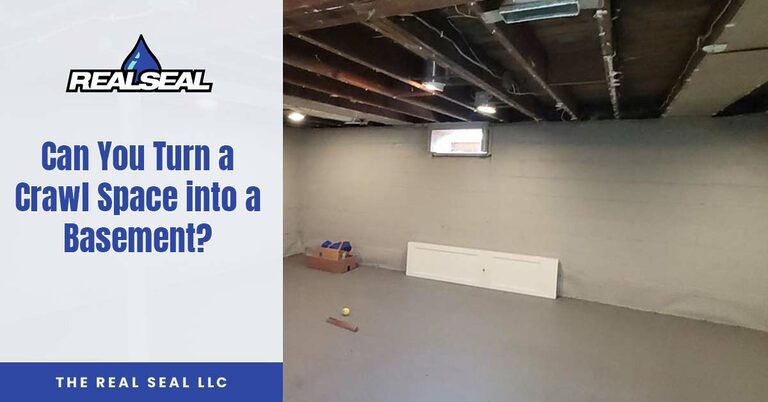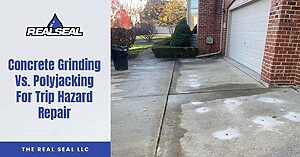If you are searching for a way to enhance your crawl space, you may have wondered if you can turn a crawl space into a basement.
As outlandish as this idea may sound, converting a crawl space into a basement is entirely possible. That said, the process involved in this transformation is challenging and time-consuming. Only skilled foundation professionals with past conversion experience stand a decent chance of performing this task correctly.
The purpose of this article is to clue you into the many necessary steps that make crawl space conversion possible. We’ll begin by discussing the basics of what crawl spaces and basements are and how they differ from each other. We’ll also cover crawl space conversion feasibility, the significant stages involved, safety considerations, and more.
By the time you finish reading, you’ll have a full understanding of what makes converting a crawl space to a full basement possible. You’ll also have a much clearer idea of whether this service is the best approach for your home.
Understanding Crawl Spaces and Basements
Before we can discuss how to convert a crawl space into a basement, we must ensure you understand what these two foundation types are and a bit about how the conversion process unfolds.
The Basics of Crawl Spaces and Basements
Even if crawl spaces and basements are familiar to you, it may be difficult for you to define each one. To help you with this preliminary knowledge, we’ve provided basic explanations for each of these foundation types:
- Crawl space: A crawl space consists of footings embedded a few feet below the earth that provide the foundation with stability. A set of perimeter walls connect to these footings and rise from a few feet beneath the ground. The house rests on top of these walls for support. The construction of the walls creates an enclosed space between the home and the ground that is just a few feet tall.
- Full basement foundation: Unlike a crawl space, a full basement consists of walls that extend at least six feet down into the earth. This depth allows the full basement to act as an entirely new floor for the home, where living and storage can take place. Like a crawl space, a basement foundation also plays the vital role of providing support for the home.
From Crawl Space to Basement: Understanding the Transformation
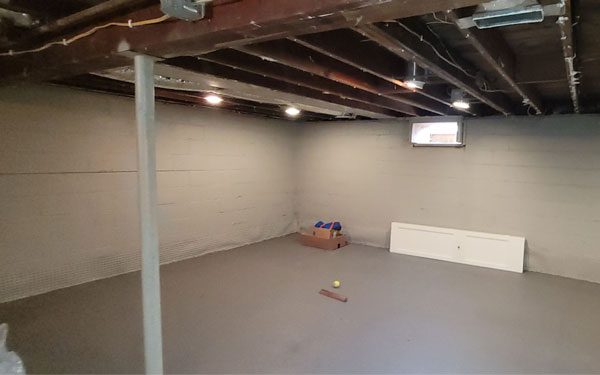
Converting a crawl space to a basement comes with a few distinct benefits. Mainly, converting to a full basement adds a considerable amount of living and storage space. After this conversion, you’ll also have the opportunity to finish your basement and rent it out if you choose.
These advantages are the primary reasons why people consider crawl space conversion. However, this conversion cannot take place without considerable foresight and technical expertise.
Feasibility Assessment
Now that the basics of crawl spaces and basements are out of the way let’s proceed to the initial steps for a conversion project. Below are some of the primary considerations that help you determine if a crawl space can be turned into a basement.
Evaluating the Feasibility of Converting Your Crawl Space
Basement conversion feasibility is the first step when considering this type of project. However, assessing feasibility is not something that the average homeowner can do on their own. Instead, it’s vital to consult a professional at this stage.
Only an experienced foundation professional can provide an accurate assessment of your crawl space. During that assessment, your foundation professional will evaluate several key factors that influence the success of a conversion project.
Key Factors That Determine Project Viability
When you hire a professional to test the feasibility of conversion for your crawl space, they’ll evaluate a specific set of factors. The list below provides you with some crucial insights regarding the details that can dramatically impact the likelihood that your conversion project proceeds as you intend:
- Crawl space condition and type: Your foundation professional should start by thoroughly inspecting your existing crawl space. Unfortunately, not all crawl spaces are viable candidates for conversion. You should rely on your professional’s insights to evaluate its overall condition and whether it can withstand the rigors involved in the conversion process.
- Local building codes: It’s crucial to review local building codes before proceeding with a crawl space conversion. Some municipalities have specific regulations regarding what you are allowed to do to your property and foundation. A conversation with a local governing body will give you a clear idea of whether conversion is permissible and what permits may be required.
- Soil structure: Your foundation professional should also evaluate the overall structural stability of the soil under your home. If the soil structure is lacking in some way, it may be unable to support a full foundation or may present problems during the conversion work.
- Water table: High water tables can be detrimental to any project that involves significant excavation. Before starting a conversion project, ensure that the water table will not interfere with the excavation.
- Existing utilities: Many crawl spaces include utilities. As such, it’s necessary to have a detailed plan of where these utilities will exist in the new basement foundation. It’s also required that utilities are evaluated to ensure that they receive no damage during the conversion process.
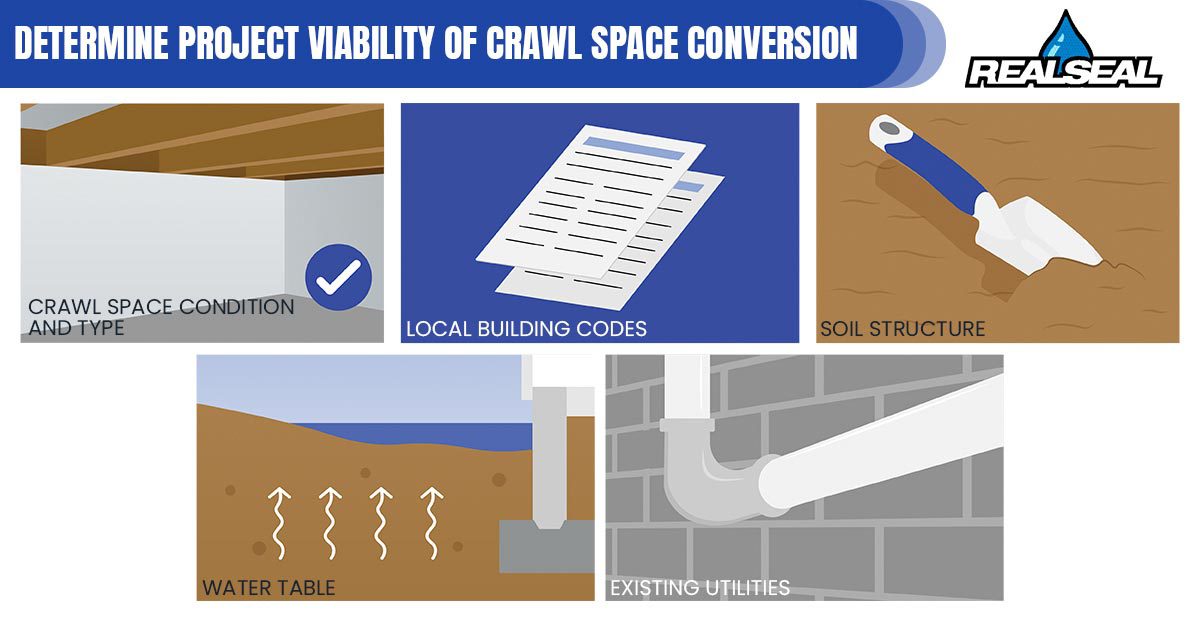
The Conversion Process
After completing the initial feasibility study and determining that you can convert your crawl space to a basement, it’s time to proceed with the crawl space conversion process. Again, this process is highly technical and includes many nuances. It’s important for your foundation team to follow all necessary steps to avoid unnecessary challenges and ensure your conversion is a success.
Step-by-Step Guide to Converting a Crawl Space into a Basement
While there are many additional details involved in crawl space conversion, this process includes a few main steps. Below are the primary stages of the crawl space conversion process that your foundation professional must complete:
- Provide initial support for the home: Your home depends on the foundation for support. However, during the conversion, your foundation will be unable to provide this essential function. As such, the foundation team will need to provide some form of temporary support for the home. This support can come from I-Beams, scaffolding, or cribbing. This can also be accomplished by digging out the crawl space in 4-5 foot sections, eliminating the need for the above cribbing.
- Dig out the crawl space: After providing adequate support for the home, it’s time to dig out the crawl space. During this stage, the team will excavate to the proper depth for a full basement while removing all unneeded parts of the crawl space.
- Create the full basement: Once excavation is complete, it’s time to fill the empty space below your home with a full basement. Ensuring this basement reaches a depth of six to eight feet allows it to become a living space in the future.
- Connect the new basement: Next, the foundation team must connect the new basement foundation to the remaining portions of your crawl space.
- Provide added support: In some scenarios, it’s necessary to provide additional support for your new basement foundation. One of the best ways to do this is by installing foundation piers.
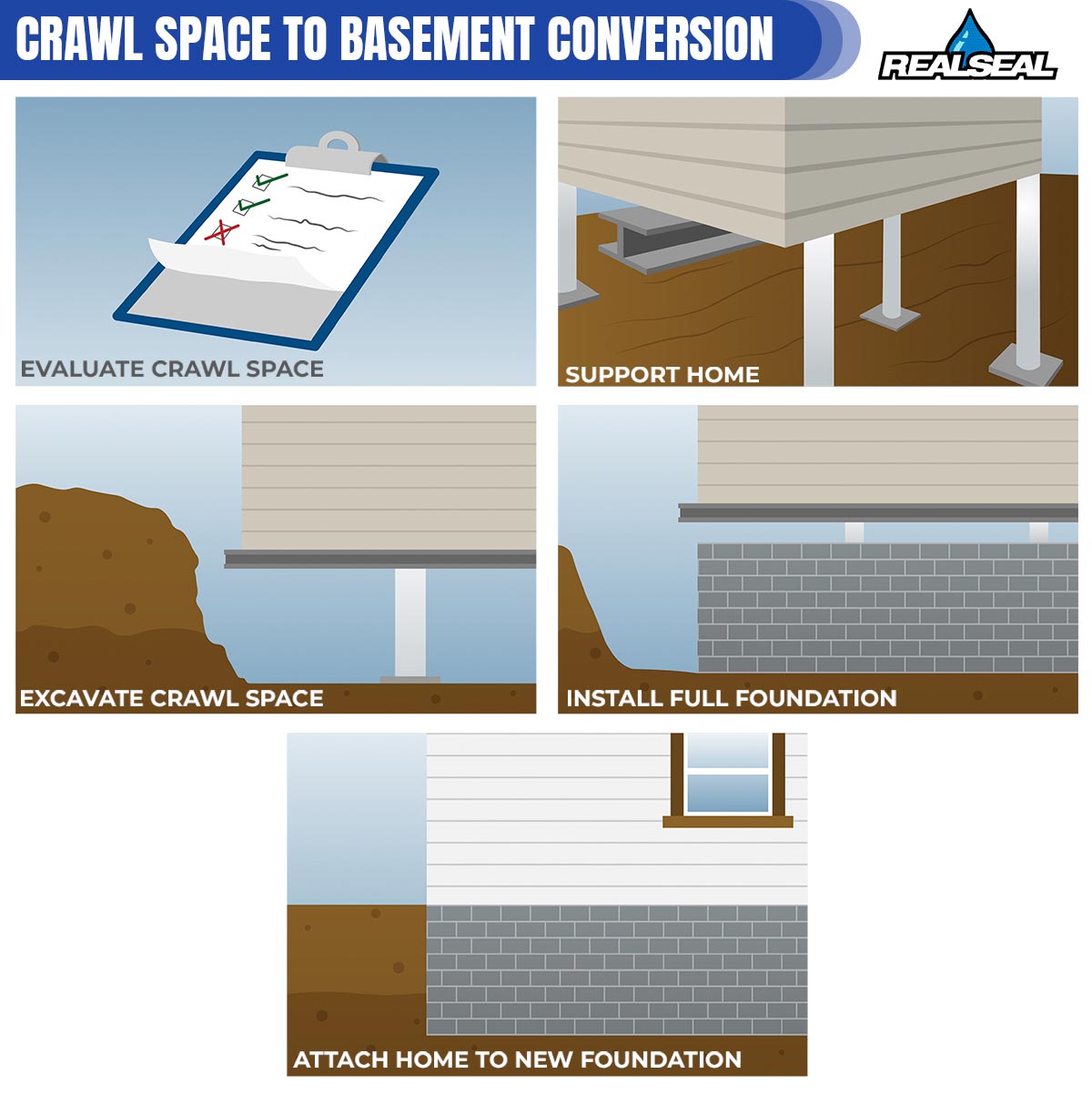
Completing the steps above results in a new basement foundation for your home. However, there are many additional details involved in this process and challenges that can arise while the work takes place.
Overcoming the Challenges: What to Expect During the Conversion
As noted above, there are plenty of challenges that a foundation team can face during a conversion project. These challenges increase the difficulty of the work, and they can make the project take much longer than expected. Below are some common challenges your foundation team should be aware of:
- Water management challenges: Managing water can be tricky during the transition from a crawl space to a foundation. Not only does the team need to assess the water table, but they must also prevent water from seeping into the hole they excavated.
- Damage to existing structures: During a conversion project, it’s very easy to damage the existing structures and utilities attached to the underside of your home. Since many of these structures must remain functional following conversion, damage will require repairs and can lengthen the overall process.
- Unexpected underground objects: Even if your team evaluates the water table before starting their work, they may encounter other complications during their excavation. Large roots, boulders, and other objects all impede your team’s ability to complete their work efficiently.
Cost Considerations
The total cost to convert a crawl space to a basement is something you should evaluate before beginning this project. Since crawl space conversions are extensive and technical, it’s only natural that the price related to this service is relatively high. The sections below provide an estimate of how much you can expect to spend and some methods you can use to cover the cost of this project.
How Much Does It Cost to Convert a Crawl Space into a Basement?
As mentioned above, the cost of converting a crawl space into a basement is relatively high. With that said, the total price you can expect to pay will vary depending on many factors. Since pricing for conversion can vary so much, the best we can do is provide an estimated range of conversion costs.
In many scenarios, the average cost to convert a crawl space to a basement falls somewhere between $60,000 and $150,000. The overall size, required excavation, utility requirements, and other factors can all cause this figure to rise.
Get the Crawl Space Conversion Guidance You Need
Is it possible to convert a crawl space into a basement? The answer to that question is absolutely yes! However, there are many factors you need to consider before turning a crawl space into a basement. If you manage these factors successfully, your conversion should go well, allowing you to enjoy the added storage and living space a full basement provides.
With that said, no conversion process can be successful without professional guidance. If you are in the Chicagoland area and you are considering crawl space conversion, reach out to The Real Seal for assistance. Our team has the knowledge and experience you need to ensure your crawl space transformation is a success.
